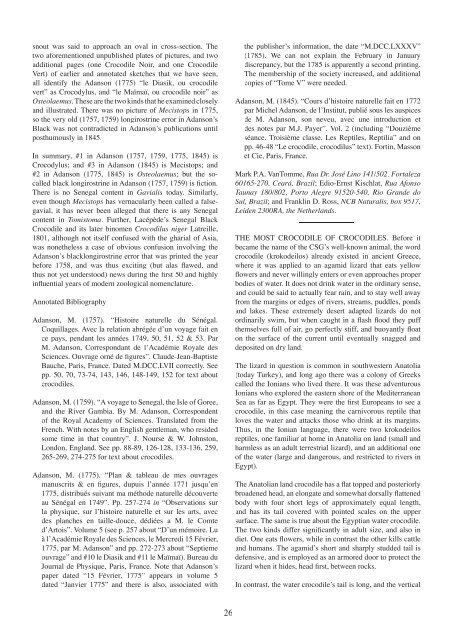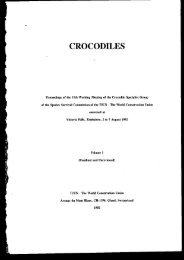CROCODILE SPECIALIST GROUP NEWSLETTER
CROCODILE SPECIALIST GROUP NEWSLETTER
CROCODILE SPECIALIST GROUP NEWSLETTER
You also want an ePaper? Increase the reach of your titles
YUMPU automatically turns print PDFs into web optimized ePapers that Google loves.
snout was said to approach an oval in cross-section. The<br />
two aforementioned unpublished plates of pictures, and two<br />
additional pages (one Crocodile Noir, and one Crocodile<br />
Vert) of earlier and annotated sketches that we have seen,<br />
all identify the Adanson (1775) “le Diasik, ou crocodile<br />
vert” as Crocodylus, and “le Maïmaï, ou crocodile noir” as<br />
Osteolaemus. These are the two kinds that he examined closely<br />
and illustrated. There was no picture of Mecistops in 1775,<br />
so the very old (1757, 1759) longirostrine error in Adanson’s<br />
Black was not contradicted in Adanson’s publications until<br />
posthumously in 1845.<br />
In summary, #1 in Adanson (1757, 1759, 1775, 1845) is<br />
Crocodylus; and #3 in Adanson (1845) is Mecistops; and<br />
#2 in Adanson (1775, 1845) is Osteolaemus; but the socalled<br />
black longirostrine in Adanson (1757, 1759) is fiction.<br />
There is no Senegal content in Gavialis today. Similarly,<br />
even though Mecistops has vernacularly been called a falsegavial,<br />
it has never been alleged that there is any Senegal<br />
content in Tomistoma. Further, Lacépède’s Senegal Black<br />
Crocodile and its later binomen Crocodilus niger<br />
Latreille,<br />
1801, although not itself confused with the gharial of Asia,<br />
was nonetheless a case of obvious confusion involving the<br />
Adanson’s blacklongirostrine error that was printed the year<br />
before 1758, and was thus exciting (but alas flawed, and<br />
thus not yet understood) news during the first 50 and highly<br />
influential years of modern zoological nomenclature.<br />
Annotated Bibliography<br />
Adanson, M. (1757). “Histoire naturelle du Sénégal.<br />
Coquillages. Avec la relation abrégée d’un voyage fait en<br />
ce pays, pendant les années 1749, 50, 51, 52 & 53. Par<br />
M. Adanson, Correspondant de l’Académie Royale des<br />
Sciences. Ouvrage orné de figures”. Claude-Jean-Baptiste<br />
Bauche, Paris, France. Dated M.DCC.LVII correctly. See<br />
pp. 50, 70, 73-74, 143, 146, 148-149, 152 for text about<br />
crocodiles.<br />
Adanson, M. (1759). “A voyage to Senegal, the Isle of Goree,<br />
and the River Gambia. By M. Adanson, Correspondent<br />
of the Royal Academy of Sciences. Translated from the<br />
French. With notes by an English gentleman, who resided<br />
some time in that country”. J. Nourse & W. Johnston,<br />
London, England. See pp. 88-89, 126-128, 133-136, 259,<br />
265-269, 274-275 for text about crocodiles.<br />
Adanson, M. (1775). “Plan & tableau de mes ouvrages<br />
manuscrits & en figures, dupuis l’année 1771 jusqu’en<br />
1775, distribués suivant ma méthode naturelle découverte<br />
au Sénégal en 1749”. Pp. 257-274 in “Observations sur<br />
la physique, sur l’histoire naturelle et sur les arts, avec<br />
des planches en taille-douce, dédiées a M. le Comte<br />
d’Artois”. Volume 5 (see p. 257 about “D’un mémoire. Lu<br />
à l’Académie Royale des Sciences, le Mercredi 15 Février,<br />
1775, par M. Adanson” and pp. 272-273 about “Septieme<br />
ouvrage” and #10 le Diasik and #11 le Maïmaï). Bureau du<br />
Journal de Physique, Paris, France. Note that Adanson’s<br />
paper dated “15 Février, 1775” appears in volume 5<br />
dated “Janvier 1775” and there is also, associated with<br />
the publisher’s information, the date “M.DCC.LXXXV”<br />
(1785). We can not explain the February in January<br />
discrepancy, but the 1785 is apparently a second printing.<br />
The membership of the society increased, and additional<br />
copies of “Tome V” were needed.<br />
Adanson, M. (1845). “Cours d’histoire naturelle fait en 1772<br />
par Michel Adanson, de l’Institut, publié sous les auspices<br />
de M. Adanson, son neveu, avec une introduction et<br />
des notes par M.J. Payer”. Vol. 2 (including “Douzième<br />
séance. Troisième classe. Les Reptiles, Reptilia” and on<br />
pp. 46-48 “Le crocodile, crocodilus” text). Fortin, Masson<br />
et Cie, Paris, France.<br />
Mark P.A. VanTomme, Rua Dr. José Lino 141/502, Fortaleza<br />
60165-270, Ceará, Brazil; Edio-Ernst Kischlat, Rua Afonso<br />
Taunay 180/802, Porto Alegre 91520-540, Rio Grande do<br />
Sul, Brazil; and Franklin D. Ross, NCB Naturalis, box 9517,<br />
Leiden 2300RA, the Netherlands.<br />
THE MOST <strong>CROCODILE</strong> OF <strong>CROCODILE</strong>S. Before it<br />
became the name of the CSG’s well-known animal, the word<br />
crocodile (krokodeilos) already existed in ancient Greece,<br />
where it was applied to an agamid lizard that eats yellow<br />
flowers and never willingly enters or even approaches proper<br />
bodies of water. It does not drink water in the ordinary sense,<br />
and could be said to actually fear rain, and to stay well away<br />
from the margins or edges of rivers, streams, puddles, ponds<br />
and lakes. These extremely desert adapted lizards do not<br />
ordinarily swim, but when caught in a flash flood they puff<br />
themselves full of air, go perfectly stiff, and buoyantly float<br />
on the surface of the current until eventually snagged and<br />
deposited on dry land.<br />
The lizard in question is common in southwestern Anatolia<br />
(today Turkey), and long ago there was a colony of Greeks<br />
called the Ionians who lived there. It was these adventurous<br />
Ionians who explored the eastern shore of the Mediterranean<br />
Sea as far as Egypt. They were the first Europeans to see a<br />
crocodile, in this case meaning the carnivorous reptile that<br />
loves the water and attacks those who drink at its margins.<br />
Thus, in the Ionian language, there were two krokodeilos<br />
reptiles, one familiar at home in Anatolia on land (small and<br />
harmless as an adult terrestrial lizard), and an additional one<br />
of the water (large and dangerous, and restricted to rivers in<br />
Egypt).<br />
The Anatolian land crocodile has a flat topped and posteriorly<br />
broadened head, an elongate and somewhat dorsally flattened<br />
body with four short legs of approximately equal length,<br />
and has its tail covered with pointed scales on the upper<br />
surface. The same is true about the Egyptian water crocodile.<br />
The two kinds differ significantly in adult size, and also in<br />
diet. One eats flowers, while in contrast the other kills cattle<br />
and humans. The agamid’s short and sharply studded tail is<br />
defensive, and is employed as an armored door to protect the<br />
lizard when it hides, head first, between rocks.<br />
In contrast, the water crocodile’s tail is long, and the vertical<br />
26
















